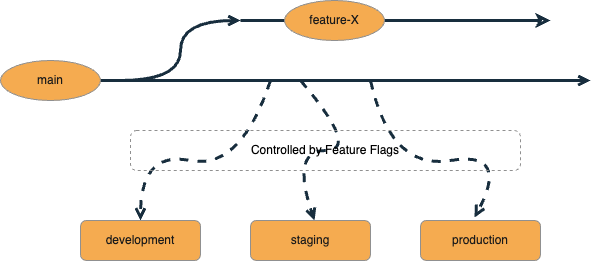Mondoo Update: AI-Powered Fixes and What's New
A lot has happened in the eight months since we covered Mondoo's March 2025 release. If you're already using the platform, you've probably noticed some big

Trunk-Based Development (TBD) means everyone integrates to a single branch: usually main or trunk. There are almost no long-lived branches or repo forks. Instead, environments are derived dynamically through deployment pipelines and configuration.
This approach is at the heart of elite DevOps and “Continuous Deployment” teams.
A pipeline that supports TBD should prioritize:
main.main via automated pipelines.
main. 1# .github/workflows/deploy.yml
2# .github/workflows/ci.yml
3name: CI Pipeline
4
5on:
6 push:
7 branches: [main]
8 pull_request:
9 branches: [main]
10
11jobs:
12 lint:
13 ...
14
15 test:
16 ...
17
18 build:
19 ...
20
21 deploy-preview:
22 runs-on: ubuntu-latest
23 if: github.event_name == 'pull_request'
24 needs: build
25 steps:
26 - name: Deploy Preview
27 run: echo "Deploying PR preview environment"
28
29 deploy-production:
30 runs-on: ubuntu-latest
31 if: github.ref == 'refs/heads/main' && github.event_name == 'push'
32 needs: build
33 steps:
34 - name: Deploy to Production
35 run: echo "Deploying to production"
1stages:
2 - lint
3 - test
4 - build
5 - deploy
6
7variables:
8 NODE_ENV: test
9
10
11lint:
12 stage: lint
13 ...
14
15test:
16 stage: test
17 needs: [lint]
18 ...
19
20build:
21 stage: build
22 needs: [test]
23 ...
24
25deploy_preview:
26 stage: deploy
27 needs: [build]
28 only:
29 - merge_requests
30 ...
31
32deploy_production:
33 stage: deploy
34 only:
35 - main
36 needs: [build]
37 ...
Trunk-Based Development is ideal for high-frequency delivery and low-overhead pipeline automation. It requires robust automated testing, continuous integration, and feature flags—but unlocks rapid feedback and streamlined releases.
Ready to evolve your environments? Trunk-based may be your next step!
You are interested in our courses or you simply have a question that needs answering? You can contact us at anytime! We will do our best to answer all your questions.
Contact us